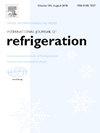Comparative study on adaptable intelligent frost recognition method for air-source heat pump and cold chain based on image texture features under complex lighting conditions
IF 3.5
2区 工程技术
Q1 ENGINEERING, MECHANICAL
International Journal of Refrigeration-revue Internationale Du Froid
Pub Date : 2025-04-08
DOI:10.1016/j.ijrefrig.2025.03.047
引用次数: 0
Abstract
The energy efficiency enhancement of refrigeration/heat pump systems is a crucial aspect of carbon emissions reduction. Accurately recognizing the frosting state of their evaporators in low-temperature environments to achieve precise defrosting is key to reducing system energy consumption. Intelligent recognition methods based on evaporator images hold promise for high recognition rates. However, in practical conditions, light intensity can severely reduce the identification accuracy of existing methods, necessitating improvements. Therefore, a highly adaptable new method based on texture features of evaporator surface images is presented in this study, where texture features is extracted by minimum-redundancy-maximum-relevance-enhanced gray level co-occurrence matrix, and classified by sparrow-algorithm-optimized extreme learning machine (GLCM-SELM), to overcome the impact of various light intensity. This method is validated using a dataset of 4125 evaporator images of three frosting states, which is experimentally collected under light intensity ranging from 5 to 2370 lx. Performance study and comparative analysis against existing methods are carried out. Results indicate that the new method achieves identification accuracy of approximately 95 % across different conditions, significantly outperforming existing methods by 6 % to 35 %. Its remarkably smaller standard deviation (0.05) demonstrates high stability. It also shows fast computing speed and low cost. Generally, it has good application potential.
复杂光照条件下基于图像纹理特征的空气源热泵与冷链自适应智能霜冻识别方法比较研究
提高制冷/热泵系统的能源效率是减少碳排放的一个重要方面。准确识别其蒸发器在低温环境下的结霜状态,实现精确除霜是降低系统能耗的关键。基于蒸发器图像的智能识别方法有望实现高识别率。然而,在实际条件下,光强会严重降低现有方法的识别精度,需要改进。因此,本研究提出了一种基于蒸发器表面图像纹理特征的高适应性新方法,该方法采用最小冗余度-最大相关性增强灰度共生矩阵提取纹理特征,并采用窄幅算法优化的极限学习机(GLCM-SELM)进行分类,以克服不同光照强度的影响。利用在5 ~ 2370 lx光强范围内实验采集的3种结霜状态下的4125张蒸发器图像数据集对该方法进行了验证。对现有方法进行了性能研究和对比分析。结果表明,新方法在不同条件下的识别准确率约为95%,显著优于现有方法6%至35%。其标准差显著小于0.05,具有较高的稳定性。计算速度快,成本低。总的来说,它具有很好的应用潜力。
本文章由计算机程序翻译,如有差异,请以英文原文为准。
求助全文
约1分钟内获得全文
求助全文
来源期刊
CiteScore
7.30
自引率
12.80%
发文量
363
审稿时长
3.7 months
期刊介绍:
The International Journal of Refrigeration is published for the International Institute of Refrigeration (IIR) by Elsevier. It is essential reading for all those wishing to keep abreast of research and industrial news in refrigeration, air conditioning and associated fields. This is particularly important in these times of rapid introduction of alternative refrigerants and the emergence of new technology. The journal has published special issues on alternative refrigerants and novel topics in the field of boiling, condensation, heat pumps, food refrigeration, carbon dioxide, ammonia, hydrocarbons, magnetic refrigeration at room temperature, sorptive cooling, phase change materials and slurries, ejector technology, compressors, and solar cooling.
As well as original research papers the International Journal of Refrigeration also includes review articles, papers presented at IIR conferences, short reports and letters describing preliminary results and experimental details, and letters to the Editor on recent areas of discussion and controversy. Other features include forthcoming events, conference reports and book reviews.
Papers are published in either English or French with the IIR news section in both languages.

 求助内容:
求助内容: 应助结果提醒方式:
应助结果提醒方式:


